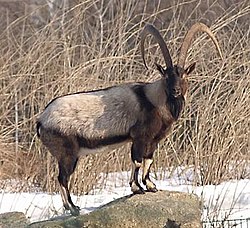| Wild goat Temporal range: Pleistocene - Recent | |
|---|---|
 | |
| Bezoar ibex, Capra aegagrus aegagrus | |
| Scientific classification | |
| Kingdom: | Animalia |
| Phylum: | Chordata |
| Class: | Mammalia |
| Order: | Artiodactyla |
| Family: | Bovidae |
| Subfamily: | Caprinae |
| Genus: | Capra |
| Species: | C. aegagrus |
| Binomial name | |
| Capra aegagrus Erxleben, 1777 | |
| Subspecies | |
Capra aegagrus aegagrus Contents | |
The wild goat (Capra aegagrus) is a wild goat species, inhabiting forests, shrublands and rocky areas ranging from Turkey and the Caucasus in the west to Iran, Turkmenistan, Afghanistan and Pakistan in the east. It has been listed as near threatened on the IUCN Red List and is threatened by destruction and degradation of habitat. [1]
It is thought to be the ancestor of the domestic goat (C. hircus). [3]



